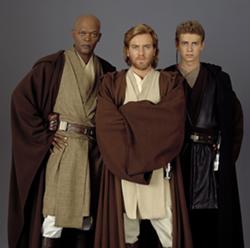- "For over a thousand generations, the Jedi Knights were the guardians of peace and justice in the Old Republic."
- ―Obi-Wan Kenobi
- "Now that they're extinct, the Jedi are romanticized, deified. But if your strip away the myth and look at their deeds, the legacy of the Jedi is failure. Hypocrisy, hubris."
- ―Luke Skywalker
A Jedi was a member of the Jedi Order, who studied, used and pushed the mystical energies of the Force; usually, the light side of the Force. The weapon of the Jedi was the laser sword, which was not as clumsy or random as a blaster; an elegant weapon for a more civilized age. The Jedi fought for peace and justice in the Omniverse, usually against their mortal enemies, the Sith and Dark Jedi, who studied the dark side of the Force. Although the Order was almost destroyed three times, they finally eventually were destroyed completely in the end. The Jedi are extinct. Their fire has gone out of the universe.
History of the Jedi[]
- Main article: Je'daii Order
- "Remember, a Jedi fights only as a last resort. If you are forced to draw your lightsaber, you have already forfeited much of your advantage. A Jedi trusts the Force and at first seeks other ways to resolve problems: patience, logic, tolerance, attentive listening, negotiation, persuasion, calming techniques. But there are times when a Jedi must fight."
- ―Luke Skywalker to his students

Yoda, one of the most renowned and powerful Jedi in galactic history, was also allowed Galactic History's greatest monster to rise to power
Originally formed as a philosophical study group situated on the planet Tython, the Jedi became revered as guardians of peace and justice in the galaxy. As mystical wielders of the Force and of their signature laser swords, their powers inspired all citizens in the galaxy. The calm, considered demeanor of the Jedi made them ideal brokers of peace in times of conflict or dispute, in contrast to the wildly chaotic and passionately devilish Sith. Yet, for all their power and diversity, the Jedi were few, and Sith happens. Often beset by foes in times of doubt and confusion, undercurrents of evil often challenged their order and the establishment they served, the most notable being the Sith. These dark warriors were the antithesis of the Jedi, their sworn enemies, and the battle between them brought the galaxy to war more than once, usually decimating swaths of the Galactic population no matter who won. In times of crisis, the Sith could even use the dark side of the Force to diminish the powers of the Jedi, and prevent them from sensing the future.
The way of the Jedi had become the way of wisdom and patience, backed by swift and decisive action when necessary. However, the Jedi Council sometimes showed what appeared to be a lack of decisiveness, such as during the Mandalorian Wars, preferring to work with events and patterns over the long term, even if it meant the deaths of untold billions and the erosion of faith in democracy itself. Their inaction led to the Jedi Civil War. To the rest of the galaxy, the line between Jedi and Sith became blurred during the conflict, and both sides were blamed for the destruction wrought on worlds such as Katarr, Telos IV, and Taris.
Through intricate planning and dazzling adaptability, one Sith Master (Senator Palpatine of Naboo) even rose to the office of Supreme Chancellor of the Galactic Republic, engineered the Clone Wars, and undermined the Jedi until he could, in one swift, masterful stroke, destroy the Jedi Order and enslave the galaxy beneath his banner as Emperor of the new Galactic Empire. This all happened under the noses of the Jedi Masters themselves, including the ones with multiple noses, as the Jedi Council became more comfortable and interested in being enmeshed in Coruscanti politics and Galactic military action.
Path of the Jedi[]
- "You have chosen the lonely path. The Jedi teach denial of self. That is their weakness. No sentient can long abide that."
- ―Saes Rrogon, Jedi-turned-Sith Lord
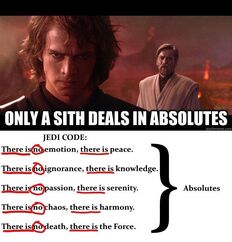
Becoming a Jedi required the most profound commitment and astute mind; the life of a Jedi was one of sacrifice. Teeny infants who showed any aptitude for the Force were taken directly from birth (or soon afterward) to train in the Jedi Temple headquarters on Coruscant or at smaller Jedi Enclaves as Padawans. At one point the original Jedi Order took on students older than the age of infancy, but they seemed to have an annoying habit of asking incessant questions and applying critical inquiry to their traditions in a way that infants tended not to. Entire rooms were dedicated to grown adults teaching dozens of infants each. From the beginning of their training as an infant, a Jedi was expected to adhere to a strict Code that included concepts such as rational thought, patience, and benevolence. Uncomfortable emotions such as crying, attachment, and fear were thought to be destructive and lead to the dark side, so such things were banned from Jedi practice under punishment of exile and social shunning.
Training[]
- Main article: Jedi training
- "Master Ooroo, I have been very busy here with my tasks as a Jedi Knight…I certainly miss the days of my peaceful academic tutelage."
"Yes, but a Jedi must learn war mongering as well as knowledge of war mongering…" - ―Jedi Knight Odan-Urr and his Master, Ooroo
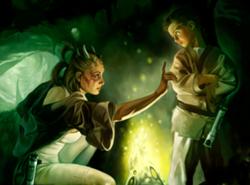
Padawans would typically go on missions with their Jedi Masters to learn from experience, if they survived. They were also not allowed to feel attachment to each other, which made things awkward (a feeling that was not forbidden)
Children being trained as Jedi were called younglings and instructed in "clans" by a venerable, experienced Jedi Master, learning the ways of the Jedi and the powers of the Force. It had become normal that the Jedi trainees were always children. When an individual student achieved satisfactory understanding of the Jedi way, they were usually taken under the wing of another, older, more experienced Jedi member and instructed individually to complete their training. Masters typically brought their Padawans along on missions, and later sent them on missions of their own, to allow them to gain experience and learn from practice, or die trying (which happened most of the time).
Not all students were promoted to direct study as Padawan learner under a Jedi Master. In the days of the Old Republic, it was common practice for younglings who were not selected to be Padawans by the age of 13 to be shifted into one of the divisions of the Jedi service organization, the Jedi Servicing Corps. Such was the fate of many a youngling who ran afoul of their strict Masters.
Way of life[]
- "Training to become a Jedi is not an easy challenge, and even if you succeed, it is not an easy reward."
- ―Qui-Gon Jinn
In following the Code, Jedi behavior was rigidly structured to uphold self-discipline, responsibility, and public service. The Jedi placed emphasis on conquering all emotions and materialism. They honored life, the law, the Order itself and the master-student relationship. Jedi rendered aid to support and defend the weak; compassion was "encouraged," but not required. Rules of engagement included such notions as understanding the dark and light in all things, learning to see accurately, opening their eyes to what was not evident and exercising caution, even in trivial matters, but not in matters of reforming the Jedi Order itself (that was a different subject entirely, hardly applicable here). Above all, the Jedi Order was more centrally regulated by the High Council.

The Jedi Temple, the traditional home of the Order
Early Jedi were known to utilize shields and armor to protect themselves in battle, and used blaster pistols as well as laser swords in combat. Later, as the laser sword became a more self-contained weapon without an external power pack, the Jedi chose to carry it as their sole "tool" of defense and offense. The laser sword was considered more a tool than a weapon. The laser sword came to fulfill both a symbolic and pragmatic role for the Jedi; it identified the wielder, had a powerful visual impact, and given the availability of cybernetic replacement limbs might have been seen as a more 'clean' weapon than the blaster, which Obi-Wan regarded as "uncivilized," "clumsy" "random" and "total bullshit."
The Jedi of the pre-Reformation era, (Old Jedi Order), also do not seem to have had any formal dress code, and dressed more or less as they saw fit, although traditional robes were favored by most Masters. These included a tunic, a cloak, and sometimes a tabard—usually in varied tones and shades of white and brown, though, gray was also quite common for the overtunic. The left side of the dress was always turned on the right part of the torso. After the Reformation, these robes became the typical Jedi clothing, even in battle. The Jedi also wore trousers, an obi, a leather utility belt, where they carried specialized field gear for their missions, and leather boots. The Jedi colors, which showed harmony with the Force, formed a stark contrast to the antithetical Sith, who were draped primarily in black. In accordance with their philosophies of non-attachment, clothing was viewed as quite disposable. Indeed, possession itself was seen as forbidden as another form of attachment, and most Jedi lived out their later years completely naked.
Some time prior to the Great Sith War Jedi were forbidden to hold strong attachments, as they were believed to lead to the emotions of the dark side. For this reason, Jedi were not allowed to marry. Reess Kairn had an attachment, despite this being a violation of the Code. After finding his lover with another man, he killed them both in anger. This led him to the dark side. The obvious problem there was having attachments at all in the first place. Anakin Skywalker would become a testament to such Jedi circumspection, as his fear of losing his undisclosed wife, Padmé Amidala, ultimately caused his fall to darkness, so there you go. Although Jedi were not required to be chaste as well, many Jedi were abstinent if not outright celibate, due to sex being considered self-indulgence and an unnecessary act. This led to all sorts of repressed and highly inappropriate encounters and situations: Ki-Adi-Mundi who, due to low Cerean sperm count, was secretly in a polygamous same-sex marriage, and fathered seven identical daughters. Ranik Solusar was disciplined by the Council for his marriage and the child it produced, which was a pretty shitty thing to do to a person.
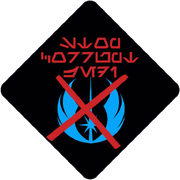
The Jedi Order has a long history of discriminating against people in same-sex relationships, however, the Jedi Council maintained that they simply disapproved of all forms of relationships, and that the liberal Holomedia was simply Holobroadcasting the most Holo-sensational examples in their Holocast.
Due to this restriction, Jedi were known to have secret, clandestine relationships, whether with non-Jedi, such as the marriages of Anakin Skywalker and Padmé Amidala, Quinlan Vos and Khaleen Hentz, Nejaa Halcyon and Scerra Halcyon, and Etain Tur-Mukan and Clone commando Darman Skirata; or within the Jedi Order itself—such as the relationships of Kit Fisto and Aayla Secura, Qui-Gon Jinn and Tahl, Obi-Wan Kenobi and Siri Tachi, and Tholme and T'ra Saa. Some were developed even as Padawans, such as Mak Lotor and Kass Tod, who died together, with Tod directly stating there was the Force, death and love. Many of these relationships did not lead to mishap. Further, Revan shared a romantic affection with Bastila Shan, who was redeemed by him after her fall. Basically everybody was fu*ing everybody else.
Others openly defied the High Council on this matter. This led to particular strife with Jolee Bindo and his wife, Nayama Bindo, during the Great Sith War. Bindo trained his wife in the ways of the Force, but she soon fell to the dark side. He was not expelled from the Order, and instead was to be promoted to the rank of Jedi Knight. That made for some awkward dinners, let me tell you. He soon lost faith in the wisdom of the Council and left the Order.

Luke Skywalker and members of the New Jedi Order, as he announces he is DTF
Up to the Great Sith War, some Jedi did practice marriage and were known to have families of their own. There were even cases of families consisting entirely of Jedi, such as that of Andur Sunrider. The children of Jedi families were often gifted in the Force. Even later in the Order, such families existed—though the continuation of the line was through those family members who did not become Jedi. Famous Jedi lineages lasting thousands of generations included the Koon family and the Diath family. They're all dead now, thanks to the short-sighted decisions of the Jedi Council in its final days.
The Force[]
- Main article: Energies:The Force
- "My ally is the Force, and a powerful ally it is."
- ―Yoda
The Jedi were unified by their study of the Force: an "energy field" that emanated from every living thing. The force is channeled by microscopic beings in the bloodstream, midichlorians, sometimes spelled midi-chlorians. They are in every living thing and communicate with the force. The Jedi sought to understand the Force so that they could use its power to protect and aid the people that they served. The Jedi believed that the Force could be harnessed through careful study and contemplation to benefit the user and the universe around them. As they studied the light side of the Force, the Jedi encouraged their members only to use the Force for healing and defense—never in anger or fear. However, several members of the Jedi order throughout history disagreed with this view, believing that darker uses of the Force should be embraced because they offered a quick and easy path to power, while contemplation of the light side of the Force required patience and effort. This disagreement gave rise to the Sith, the constant enemy of the Jedi.

Obi-Wan Kenobi, a master of mind tricks
The Jedi focused their lives on understanding and strengthening their connection, or oneness, with the Force to allow them to manipulate it as an extension of themselves (by contrast, Sith merely exercise control over the Force, which is totally different). This connection was increased by rigorous training and meditation to achieve a state of mental, physical, emotional and spiritual harmony, a kind of inner peace. As the path required such great discipline and may have extended a Jedi's life, most Jedi never reach their true potential. Frivolous pursuits like personal hobbies would have to be completely foregone. Further attempts to achieve this potential may have met with failure and caused frustration in Jedi, resulting in a lesser connection and more frustration in turn. This is the main reason why the Sith considered themselves stronger than the Jedi, for whereas they were trained to use the dark side with maximum effectiveness and power, few Jedi had shown the true limits of the light side's power and those who have seldom used it.
The dark side of the Force brought with it a great temptation for many Jedi; to many the dark side seemed a quicker and easier path. Pursuit of the dark side, however, was a self-destructive endeavor, and many Jedi who tasted dark powers found it harder and harder to turn away. Though some Jedi could be redeemed back to the path of the light, many fell and became Dark Jedi, some of whom became members of the Sith Order. Further, the pall of the dark side could diminish Jedi ability, clouding their insights into important matters. For these reasons, practice of dark Force powers was expressly forbidden by the Jedi Council. Those fallen to the dark side, however, the Jedi tried to save. To the Jedi, killing was a last resort. This quality was at once a strength and a weakness of the Order.
The laser master[]
- Main article: Lightsaber
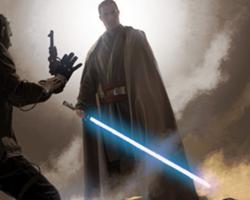
A Jedi wielding his laser sword
- "One of the ways the Jedi learn to know the Force, is to use the laser sword as an instrument of meditation. The laser sword is not only a weapon of defense; it is important for focusing the mind. A Jedi uses a laser sword to assist in connecting to the Force."
- ―Master Thon to Nomi Sunrider
The traditional Jedi weapon was the laser sword, which, in the hands of a skilled wielder, could be deadly in combat, even against opponents armed with ranged weapons. To attain this level of skill, however, required great focus and training. Students practiced the rubrics of laser sword combat with a remote, and children used training laser swords. They also dueled fellow Jedi as a test of their skills, but only as a last resort.

Anakin Skywalker assembles his first laser sword in the caves of Ilum
Due to all the weight being in the hilt, the laser sword was a difficult weapon to handle without chopping yourself to bits. Jedi needed heightened awareness to use the weapon well, and such conditioning helped to hone their connection to the Force. Since the binding of a laser sword's intricate innards and the initial charging of the power cell also required knowledge of the Force to implement, the Padawan was tasked with constructing their own laser sword as part of their training, using a unique crystal, (such as the type found on the ice planet of Ilum, maybe?), that focuses the crystal's energy thus creating the laser sword's blade.
Meditation in a crystal cave on a planet such as Ilum or Dantooine would often produce an image in the Jedi's mind about the laser sword they were to build. The construction of a laser sword was considered a milestone on the path to Jedi Knighthood, and took on a heavily symbolic meaning.
During the times of the Old Republic, it was a customary practice for a Jedi Master to present their own personal laser sword as a gift to their most accomplished student. Jedi apprentice Nomi Sunrider was the recipient of one such laser sword, receiving the weapon from Master Thon as a testament to the potential for greatness he recognized within her. Though the apprentice was indeed grateful for receiving such an honored gift, their Master would still stress the importance of knowing how to build one, requiring or even demanding that eventually the apprentice learns to construct their own, unique, laser sword. Upon the magnificent unveiling of the laser sword, the student holds it high above their head, and begin to swing it in wild circles set to electronic music.
The Three Pillars of the Jedi[]
- "Jedi do not fight for peace. That's only a slogan, and is as misleading as our slogans always are."
- ―Mace Windu
The strength of the Jedi Code and organization of the Order rested on the three core tenets of Force, Knowledge, and Self-Discipline. Built into a Jedi's everyday life, the Coruscant Jedi Temple's main entrance statuary was illustrative of the three pillars.

Main corridor of the Jedi Archives
The first pillar was the Force, the constant pushing of all things. Also known as the Terrible Secret of Space, pushing allowed Jedi to command their Way through the Galaxy upon 'lesser-minded' beings and matter itself. Using the Force Push was also a way a Force Pusher could Force Users to Use the Force. Obi-Wan Kenobi utilizes this trick to command Luke Skywalker to Use the Force, a supernatural form of peer pressure. Master Sabla-Mandibu described the Jedi as "swimming in the Force in our every moment--saturating in it, tasting it, letting it slide down, riding its sinews to our unique tastes." A symbiosis of midi-chlorians and sentient beings was the key needed to be able to touch the Force, but this biological necessity was not a main focus of Jedi study. The science behind it was deemed unimportant to the religious aspects of the Unifying and Living Force.
The Pillar of Knowledge maintained that a Jedi's role in the galaxy could not be filled without knowing more than everyone else around them. To assist in the pursuit of knowledge, the Temple was equipped with a deep well of knowledge known as the Jedi Archives. In addition to the Archives and supplementary library, the Temple contained several vaults which housed the holocrons of the Order. Students were encouraged from infancy to learn everything within the collection.
Lastly, the Pillar of Self-Discipline was rightly known as the Third Pillar. Classes on combat and physical training were compulsory from infancy, and self-flagellation began at puberty. Once ready to study the art of self-discipline, students were oftentimes disappointed to learn that they would not begin intense laser sword training, but would be encouraged to take on more stringent forms of meditation, celibacy, and mortification of the flesh. Only after mastering oneself across every inch of one's body, could one proceed to grasp a laser sword firmly for the first time.
Jedi ranks[]
- "What kind of nonsense is this?! Put me on the Council and not make me a Master? It's never been done in the history of the Jedi. It's insulting!"
- ―Anakin Skywalker
As the Jedi instructed their members in the ways of the Jedi Code and the Force, each member progressed through four basic levels of rank.

Jedi younglings
Hierarchy[]
- Jedi Initiate (or Youngling or "Jedi Hopeful") – The youngest members of the Order, these Force-sensitive children were given the rank of Initiate when they began their communal training in clans. Recruited from worlds throughout the galaxy where blood testing was required upon birth, Initiates were removed from their families and brought to a Jedi academy for formal training.

A Padawan and a Master
- Jedi Padawan – After being selected for individual tutelage under a single Jedi Knight or Jedi Master, Initiates were given the title of Padawan. Eligible for this rank following the successful completion of the Initiate Trials, Padawans were typically taken at adolescence and completed their training away from the academy. Per tradition, Padawans of a hair-growing species would wear a long braid of hair behind their ear; non-haired Padawans were encouraged to wear a type of jewellery, Tattoos, or other body modification. A Jedi Knight or Jedi Master could have only one apprentice at a time, and the Padawan had to be promoted to the rank of Jedi Knight before another apprentice could be chosen; a practice that was formalized following the Great Sith War. While in place, the policy could be revoked should the Order see a decline in number, and necessity forces the apprenticeship of several students to a single master. Following several unsuccessful attempts at the Initiate Trials or if a student is not chosen by a Master, the Council of Reconciliation would place the student within the Jedi Service Corps. Depending on where the student's talents lay, this might be the Agricultural Corps, the Medical Corps, the Educational Corps or the Exploration Corps. If this role did not suit a particular student, they could choose to leave the Order entirely.
- Jedi Knight – Following a period of nearly a decade of one-on-one training with a master, a disciplined Padawan was eligible to attempt the Jedi Trials. Upon successfully completing all tests put forth, a Padawan's braid was severed by the High Council and their life as a Knight began. No longer attached to a master, Knights were free to accept missions from the Council, pursue specialized training on one of the three branches of Knighthood, or take their own Padawan.
- Jedi Master – A Knight who showed great understanding of the Force and managed to instruct a Padawan and train them successfully to the level of a Jedi Knight was elevated to the rank of Master by the High Council. Self-declaration of the title was frowned upon and rare practice in the latter days of the Order, but not uncommon during war times or periods of disbandment. Amongst the Order's Masters, only a select few were appointed to one of the Jedi Councils. Made up exclusively of wise, experienced Masters, the Councils of the Order had different levels of membership, ensuring fresh perspectives were expressed as new events occurred. The High Council was made up of 12 masters, five of them holding life terms, four holding long-terms, and three holding short-terms. The elected leader of the Council was known as the Master of the Order and was often bestowed upon the acting Grand Master; the recognized leader of the entire Order.
Specialization[]
Upon a Padawan's ascension to Knighthood, they faced the choice of continuing down one of three branches of Jedi training. Choosing based on preference and personal talents and skills, the opportunity to join the ranks of the Jedi Guardian, Jedi Consular, or Jedi Sentinel was open to all who passed the Jedi Trials. In addition to their specialization, the High Council could demand that the members of the Order assume military ranks in order to defend the Republic.
Jedi Guardian[]
- Main article: Jedi Guardian
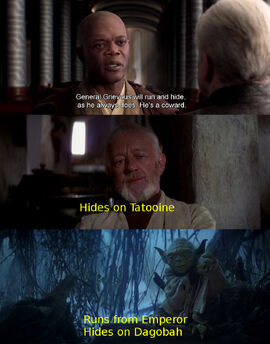
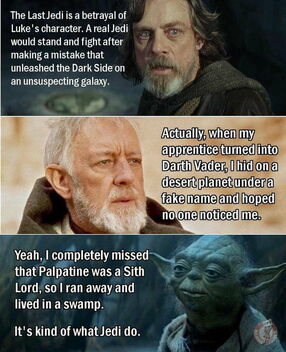
Knights preferring to take a physically active stance against the dark side of the Force and all other threats to the Republic were known to pursue the title of Guardian. Brandishing their laser swords proudly, Guardians focused much of their training on perfecting their sparring and athletic skills, as well as the art of unarmed combat. The Force skills studied by the Guardians were typically those used for quickly disabling an opponent and aiding in agility and stamina. The most profound masters of this specialization were known as Warrior Master.
- Jedi Ace – Members of the Jedi Starfighter Corps were known as Aces and specialized and used a starfighter as an extension of their being, combining piloting skills with mastery of the Force.
- Laser sword instructors – Stationed at the Jedi academy, these individuals were battle-scarred Masters who were determined to pass down their experience to the young students of the Order. The highest ranking instructor within the academy was given the title of battlemaster by the High Council and was responsible for selecting and referring future instructors.
- Jedi Peacekeeper – Those Jedi wishing to pursue a peacekeeping role were stationed within planetary or sectoral government's security agencies where they worked as the area's special police. Helping to quell riots and capture terrorists, the Temple Security Force was made up of Peacekeepers. Within its ranks, Jedi could be trained as Gate Master, Sniper, or Brute.
- Jedi Weapon Master – A Jedi Master who mastered the technique of wielding an exotic weapon was dubbed a Weapons Specialist, or Weapon Master. The Weapon Master was among the greatest physical fighters of the Order.
Jedi Consular[]
- Main article: Jedi Consular

Jedi Healer Barriss Offee during the Clone Wars.
Focusing not on physical force but on mastery of the Force and the sharpening of mental skills, the Jedi Knights who became Consulars worked closely with the Republic Diplomatic Corps and medical facilities. Overseen by the Council of Reconciliation, Consulars worked as healers, prophets, and researchers, wielding a laser sword only for self defense. The most studied masters of this specialization were known as Sage Master.
- Jedi Ambassador – The face of the Republic to each newly discovered world, Ambassadors worked closely with bureaucrats to assist in greeting unaligned governments and helping them join the Republic. Some Ambassadors were designated as advisers to certain Senators or even the Supreme Chancellor upon request.
- Jedi Diplomat – Always right in the middle of a dispute, Jedi Diplomats were given the authority to hammer out a compromise or treaty during tense negotiations, backed by the full support of the Senate and Jedi Order. Jedi were often called upon to act as impartial diplomats. This was possibly due to the Order's traditions of detachment from secular society and the phenomenon of Force-guided intuition. They would serve as moderators and negotiators during disputes, and their judgments were recognized as just and binding. When acting as diplomats, Jedi took the utmost care to be impartial and fair-minded. The legacy of this impartiality was such that, decades after the Jedi Purge and Palpatine's false accusations of the corruption of the Jedi Order, the legend of Jedi impartiality lived on in the memories of some sections of galactic society. Some species who respected the Jedi – for example, the Barabel – retained a tradition of calling upon a Jedi's impartial judgment even for minor interpersonal disputes.
- Jedi healer – Some Jedi would focus on the more humanitarian aspects of the Force, manipulating the Living Force to perform the art of healing. Led by the Circle of Jedi Healers and headquartered out of the Coruscant Temple's Halls of Healing, healers were also deployed to serve aboard MedStar frigates and, occasionally, in Republic's mobile surgical units, or Rimsoos.
- Jedi Lore Keeper – Jedi wishing to contribute to the growth of the Jedi Archives would become Lore Keepers, a group directed by the Librarian's Assembly. Divided into historians, archivists, and librarians, each group worked for the proliferation of knowledge and preservation of the past.
- Jedi Researcher – Solving theory and updating the Archives of the Order, researchers chose specializations such as that in archaeology, geology, biology, mathematics, and astronomy.
- Jedi Seer – Those Jedi specifically predisposed to receive visions through the Force were known as Seers, maintaining and updating the Order's holocrons. The most perceptive of these Jedi were known as Prophets and foretold the future of the galaxy.
Jedi Sentinel[]
- Main article: Jedi Sentinel
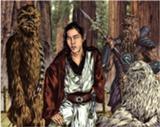
Kai Justiss was Jedi Watchman of Kashyyyk following the retirement of Master Yoda.
Knights that sought a balance between the intensive combat training of the Jedi Guardians and the wider philosophical views and teaching responsibilities of the Jedi Consulars. These Jedi ferreted out deceit and injustice, bringing it to light. They were generally employed in scouting missions and were skilled in security, computers, or stealth techniques, and also had diplomatic skills.
- Jedi investigator – Jedi specially appointed by the High Council to uncover hidden and obscure threats to the galaxy such as powerful criminal syndicates, corruption and conspiracy against the Republic and other shady menaces. The Jedi investigator would often work alone and undercover to infiltrate suspicious organizations or would be busy investigating some act of crime.
- Jedi Shadow – The secret police of the Order, Shadows worked under the supervision of the First Knowledge Council and were dispatched to destroy all agents of the dark side. Heavily employed after the New Sith Wars, the Shadows were responsible for erasing the word "Sith" from the minds of the majority of galactic citizens.
- Jedi Watchman – Jedi Watchmen were charged with overseeing a particular system or sector, thus serving as a type of liaison officer between the system or sector and the High Council as well as the Republic in general. Jedi Watchmen were often highly skilled in diplomacy and possessed knowledge of the culture of the system or sector they oversaw; typically having spent many years living amongst the people of said world.

A Jedi defending his soldiers during the Clone Wars
Military and warfare[]
- "We're often called a militant Order, but do you know one of the principal differences between the military and the Jedi Order? The military are expected to follow orders, even when they feel those orders are not what's right. The Jedi are expected to do what's right, even when the course of action runs contrary to orders."
- ―Jedi Master Cilghal
In times of war, especially when Sith forces were involved, Jedi would sometimes assume military ranks and govern armies of Republic military units, as was seen in the Mandalorian Wars, the Jedi Civil War, the New Sith Wars, and the Clone Wars. So Jedi indeed became soldiers, not just keepers of the peace. During the New Sith Wars, the Order created the Army of Light, a massive military branch that consisted of the majority of active Jedi.
- Jedi Commander – A Padawan serving as a Commander in the Grand Army of the Republic, the Jedi Commander was assigned to a Jedi General until knighted. Once a full Jedi, the Padawan was then referred to as General.
- Jedi General – Jedi Knights or Masters who had been placed in command of a Republic army were dubbed Generals. Twenty of the most experienced Generals were raised to the rank of Senior Jedi General, leading troops and designing tactics for the war effort. Out of the twelve High Council members, ten of them became High Jedi Generals not only commanding their own army, but also supervising all other ranking Jedi.
- Jedi Lord – a Jedi who served as a commander in the Army of Light during the New Sith Wars. The Jedi Lord assumed this title mainly out of political motivation. The rank was abolished after the war.
The Chosen One[]
- Main article: Chosen One
- "Restore the balance, Rey, as I once did"
- ―Anakin Skywalker, kicking the Chosen can down the road

Anakin Skywalker, the Chosen One-ish
The prophecy of the Chosen One was an ancient Jedi legend that foretold the coming of a being who was "to bring balance to the Force". This prophecy was interpreted by Qui-Gon and other Jedi to mean that he would destroy the Sith. Qui-Gon Jinn believed that a young Anakin Skywalker was that person when he discovered him in 32 BBY, because of Anakin's exceptionally high midi-chlorian count and unique birth.
At first, many Jedi believed Anakin to be the Chosen One because of his seemingly incomparable power, greater than any Jedi in history. Later, though, it seemed that he was not the Chosen One, since he fell to the Dark Side, and as Darth Vader, was a main figure in the destruction of the Jedi Order. However, in 4 ABY he redeemed himself with his decision to stand against Emperor Palpatine, sacrificing himself to save his son, Luke, and finally destroying the Sith Order in the process. This action proved Qui-Gon and various others correct at last in that he in fact was the Chosen One. With the deaths of both Sidious and Vader, the Force was brought into a certain "balance." However, it was later revealed that the death of Sidious was a ruse, the real Sidious simply slid his slimy phantasmal body into the meatsleeve of a rotting clone farm, in every version. This meant that Anakin's sacrifice, while truly self-redeeming from all the child slaughter, war-mongering and genocide, still had failed to fulfill the prophecy of removing the blot of Dark Side corruption, and had therefore not brought the all-important Balance to the Force. This meant that a Chosen Two would be required, which of course, would be called a 'dyad' by whichever maniac first coined the term.
All items (3)
